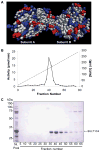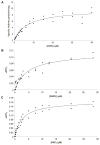Expression, purification and characterization of human cytosolic sulfotransferase (SULT) 1C4
- PMID: 28222028
- PMCID: PMC5608031
- DOI: 10.1515/hmbci-2016-0053
Expression, purification and characterization of human cytosolic sulfotransferase (SULT) 1C4
Abstract
Human cytosolic sulfotransferase 1C4 (hSULT1C4) is a dimeric Phase II drug-metabolizing enzyme primarily expressed in the developing fetus. SULTs facilitate the transfer of a hydrophilic sulfonate moiety from 3'-phosphoadenosine-5'-phosphosulfate (PAPS) onto an acceptor substrate altering the substrate's biological activity and increasing the compound's water solubility. While several of the hSULTs' endogenous and xenobiotic substrates have been identified, the physiological function of hSULT1C4 remains unknown. The fetal expression of hSULT1C4 leads to the hypothesis that the function of this enzyme may be to regulate metabolic and hormonal signaling molecules, such as estrogenic compounds, that may be generated or consumed by the mother during fetal development. Human SULT1C4 has previously been shown to sulfonate estrogenic compounds, such as catechol estrogens; therefore, this study focused on the expression and purification of hSULT1C4 in order to further characterize this enzyme's sulfonation of estrogenic compounds. Molecular modeling of the enzyme's native properties helped to establish a novel purification protocol for hSULT1C4. The optimal activity assay conditions for hSULT1C4 were determined to be pH 7.4 at 37°C for up to 10 min. Kinetic analysis revealed the enzyme's reduced affinity for PAPS compared to PAP. Human SULT1C4 sulfonated all the estrogenic compounds tested, including dietary flavonoids and environmental estrogens; however, the enzyme has a higher affinity for sulfonation of flavonoids. These results suggest hSULT1C4 could be metabolizing and regulating hormone signaling pathways during human fetal development.
Figures






References
-
- Strott CA. Sulfonation and molecular action. Endocr Rev. 2002;23:703–32. - PubMed
-
- Falany CN. Enzymology of human cytosolic sulfotransferases. FASEB J. 1997;11:206–16. - PubMed
-
- Weinshilboum RM, Otterness DM, Aksoy IA, Wood TC, Her C, Raftogianis RB. Sulfation and sulfotransferases 1: sulfotransferase molecular biology: cDNAs and genes. FASEB J. 1997;11:3–14. - PubMed
-
- Meinl W, Tsoi C, Swedmark S, Tibbs ZE, Falany CN, Glatt H. Highly selective bioactivation of 1- and 2-hydroxy-3-methylcholanthrene to mutagens by individual human and other mammalian sulphotransferases expressed in Salmonella typhimurium. Mutagenesis. 2013;28:609–19. - PubMed
-
- Glatt H. Sulfotransferases in the bioactivation of xenobiotics. Chem Biol Interact. 2000;129:141–70. - PubMed
MeSH terms
Substances
Grants and funding
LinkOut - more resources
Full Text Sources
Other Literature Sources
Molecular Biology Databases
Research Materials
